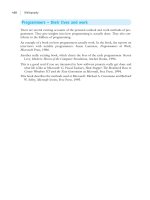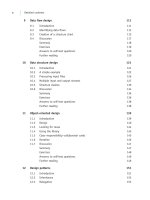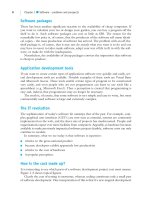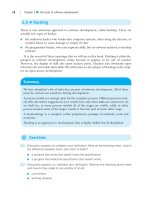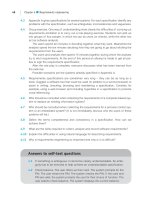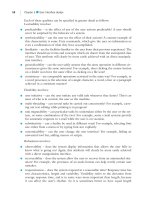Software Engineering For Students: A Programming Approach Part 24 potx
Bạn đang xem bản rút gọn của tài liệu. Xem và tải ngay bản đầy đủ của tài liệu tại đây (157.93 KB, 10 trang )
208 Chapter 15 ■ Object-oriented programming
exploit the common features of the classes. We do this by writing a class Sprite that
embodies the commonality. This name is chosen because, in computer games programs,
a sprite is the term for a graphical object. Here it is:
class Sprite {
protected int x, y;
protected size;
public void moveLeft(int amount) {
x = x - amount;
}
public void moveRight(int amount) {
x = x + amount;
}
}
You can see that the variables and methods within this class are relevant to all the
game objects. You will also notice that the variables declared at the head of the class
that were described as
public, are now described as protected. This means that they
are accessible from any subclasses, as we shall see in a moment.
We can now write class
Alien so as to exploit the class Sprite as follows:
class Alien extends Sprite {
private ImageIcon alienImage;
public Alien(int newX, int newY, int newSize) {
x = newX;
y = newY;
size = newSize;
alienImage = new ImageIcon("c:/alien.jpg");
}
public void display(JPanel panel) {
Graphics paper = panel.getGraphics();
alienImage.paintIcon(panel, paper, x, y);
}
}
and you can see that this is now shorter than it was. The operative word in this code is
extends. This is the Java keyword stating that class Alien inherits the features of class
Sprite. All the public variables and methods become part of class Alien. The ter-
minology is that
Alien is a subclass of Sprite, Sprite is the superclass of Alien,
Alien extends Sprite, Sprite is the base class of Alien.
>
>
>
>
BELL_C15.QXD 1/30/05 4:23 PM Page 208
15.5 Polymorphism 209
The relationships between classes are often shown in a UML class diagram, such as
Figure 15.2. Each class is shown as a rectangle. An arrow points from a subclass to a
superclass. This diagram says that both
Alien and Bomb are subclasses of Sprite.
The variables
x, y, and size are labeled protected rather than private. This
means that they can be used within the subclass. But they are still inaccessible from
anywhere else.
Sprite
Alien Bomb
Figure 15.2 Class diagram showing inheritance
SELF-TEST QUESTION
15.5 Write class Bomb.
Inheritance is a way of exploiting commonality between classes. Another view is that
it is a mechanism for making use of an existing class, inheriting its useful features and
adding new features. So it is a scheme for software reuse. Inheriting means that an exist-
ing class is retained intact. To use it we do not need to make changes, which might dis-
rupt the existing class. So we can safely reuse classes.
When you start to write a new program, you look for useful classes in the library and
you look at any classes you have written in the past. This object-oriented approach to
programming means that, instead of starting programs from scratch, you build on earlier
work. It’s not uncommon to find a class that looks useful, and does nearly what you
want, but not exactly what you want. Inheritance is a way of resolving this problem.
With inheritance, you use an existing class as the basis for creating a modified class.
We again use as an example the cyberspace invaders program that displays graphical
images on the screen – an alien, a bomb and similar. The program uses a class named
Sprite, which describes all the shared attributes of these images, including where they
are in the window. Here is a program fragment that uses the classes
Sprite, Alien and
15.5
●
Polymorphism
BELL_C15.QXD 1/30/05 4:23 PM Page 209
210 Chapter 15 ■ Object-oriented programming
Bomb to create two objects, storing them in an array list named game, and displaying
them. The display is shown in Figure 15.1.
Alien alien = new Alien(20, 20, 100);
Bomb bomb = new Bomb(80, 80, 10);
ArrayList game = new ArrayList();
game.add(alien);
game.add(bomb);
for (int s = 0; s < game.size(); s++) {
Object item = game.get(s);
Sprite sprite = (Sprite) item;
sprite.display(paper);
}
Polymorphism is in use here – the method display is called on two occasions with
different results according to which object is in use. You can see that the two calls of
display within the for loop:
sprite.display(paper);
give two different outputs. Two different outputs are displayed because the Java sys-
tem automatically selects the version of
display associated with the class of the object.
When method
display is first called, the variable sprite contains the object alien
and so the version of display in the class Alien is called. Then the corresponding
thing happens with
bomb. This is the essence of polymorphism.
The class of an object is determined when the object is created using new classes,
and stays the same whatever happens to the object. Whatever you do to an object in a
program, it always retains the features it had when it was created. An object can be
assigned to a variable of another class and passed around the program as a parameter,
but it never loses its true identity.
Polymorphism allows us to write a single concise statement, such as:
sprite.display(paper);
instead of a series of if statements like this:
if (sprite instanceof Alien) {
Alien alien = (Alien) sprite;
alien.display(paper);
}
if (sprite instanceof Bomb) {
Bomb bomb = (Bomb) sprite;
bomb.display(paper);
}
>
>
>
>
BELL_C15.QXD 1/30/05 4:23 PM Page 210
15.5 Polymorphism 211
which is clumsy and long-winded. This uses the keyword instanceof to ask if an
object is a member of a named class. If there are a large number of graphical objects,
there are a correspondingly large number of
if statements. Avoiding this complexity
demonstrates how powerful and concise polymorphism is.
As we have seen in this small example, polymorphism often makes a segment of pro-
gram smaller and neater through the elimination of a series of
if statements. But this
achievement is much more significant than it may seem. It means that such statements as:
sprite.display(paper);
know nothing about the possible variety of objects that may be used as the value of
sprite. So information hiding (already present in large measure in an OOP) is extend-
ed. We can check this by assessing how much we would need to change this program
to accommodate some new type of graphical object (some additional subclass of
Sprite), say a laser. The answer is that we would not need to modify it at all – we could
simply add the new object. This means that the program is enormously flexible. Thus
polymorphism enhances modularity, reusability and maintainability.
Polymorphism helps construct programs that are:
■ concise (shorter than they might otherwise be)
■ modular (unrelated parts are kept separate)
■ easy to change and adapt (for example, introducing new objects).
In general, the approach to exploiting polymorphism within a particular program is
as follows:
1. identify any similarities (common methods and variables) between any objects or
classes in the program
2. design a superclass that embodies the common features of the classes
3. design the subclasses that describe the distinctive features of each of the classes,
whilst inheriting the common features from the superclass
4. identify any place in the program where the same operation must be applied to any
of the similar objects. It may be tempting to use
if statements at this location.
Instead, this is the place to use polymorphism.
5. make sure that the superclass contains an abstract method corresponding to the
method that is to be used polymorphically.
The code fragment shown above, with an array list and a
for loop, is an example of
a commonly occurring situation in software, where the entire contents of a collection
are processed. It is so common that some languages provide a
foreach control struc-
ture. In Java, the above
for loop can be rewritten more concisely as:
for (Object item : game) {
((Sprite) item).display(paper);
}
>
>
BELL_C15.QXD 1/30/05 4:23 PM Page 211
212 Chapter 15 ■ Object-oriented programming
Each time that the for statement repeats, it obtains the next element from the array
list
game.
As we have seen, Java supports single inheritance – a class can inherit from only one
immediate superclass. Seen as a class diagram, the relationships between classes appear
as a tree (a computer science tree, with the root at the top). Smalltalk, Ada, C# and
Visual Basic.Net also provide single inheritance.
However, the widely used language C++ provides multiple inheritance, as does
Eiffel. In such a language, a class can inherit from not just one but several superclasses.
In life we are not just a person, we also belong to other categories, such as brothers,
daughters, soccer lovers, carnivores. So a class representing a person is a subclass of all
these superclasses, inheriting variables and methods from them all.
There is no doubt that multiple inheritance is more complicated – both to provide
in the language and to use. C++ was widely seen as an overcomplicated language and
subsequent languages, such as Java and C#, have seen simplifications in many areas,
including abandoning multiple inheritance in favor of single. In some languages,
including Java and C#, one role of multiple inheritance has been replaced by the inter-
face facility described in Chapter 16 on programming in the large.
The strong typing philosophy of programming languages like Java and Ada can have a
detrimental effect on programming efficiency. For example, suppose we defined a stack of
strings class with the normal stack operations of
push and pop, as posed in the self-test
question above. If we subsequently needed another stack type but one in which the ele-
ments were Booleans rather than strings then clearly the specification and implementation
would be identical apart from the different stack element types. In some languages, our only
recourse would be to duplicate the stack code, but with minor differences. A more power-
ful stack abstraction is required which allows the stack element type to be parameterized.
We will use the Java cyberspace invaders game discussed above to see how generics
can be used. An array list named
game contains objects representing various items
(alien, bomb, laser) at various positions within a panel. To display all the shapes, we exe-
cute a loop:
for (int s = 0, s < game.size(); s++) {
sprite sprite = (Sprite) game.get(s);
sprite.display(paper);
}
Notice that the objects retrieved from the array list need to be casted into Sprite
objects using a casting operator, (Sprite) in this case. This is because an array list
15.7
●
Generics
15.6
●
Single versus multiple inheritance
>
>
BELL_C15.QXD 1/30/05 4:23 PM Page 212
15.8 Dynamic data structures and pointers 213
holds only objects of the class Object. We can avoid this if we create an array list that
can only contain
Sprite objects, as follows:
ArrayList <Sprite> shapes = new ArrayList();
The declaration, with the class Sprite enclosed in diamond brackets, says that this
new array list is to contain only
Sprite objects. Remember that ArrayList is a Java
library class. We have qualified it by saying it must contain only
Sprite objects. So now
we can avoid the casting operation, rewriting the above as follows:
for (int s = 0, s < game.size(); s++) {
Sprite sprite = game.get(s);
sprite.display(paper);
}
But there is much more to be gained than brevity. The compiler can check that only
objects of the class
Sprite (or its subclasses) are added to the array list in statements
such as:
game.add(alien);
Thus errors can be caught at compile time, rather than at (more embarrassingly) run
time. The run-time error would be an
InvalidCastException when an object copied
from the array list is casted.
In summary, generics allow more concise programming (by avoiding casting) and
better compile-time checking.
>
>
SELF-TEST QUESTIONS
15.6 Write a method that accepts as a parameter an array list of String objects.
Each string is an integer number. Return the sum of the numbers.
15.7 Suggest a drawback of generics.
Generics are provided in Ada, Java and C++ but are not provided in C.
Many programs need to acquire temporary memory to carry out their task. Examples
are a graphics program that needs to acquire sufficient memory to represent an image
in memory, and a word processor that needs memory to hold the text of a document.
In the cyberspace invaders game, objects representing lasers and bombs are created and
destroyed.
15.8
●
Dynamic data structures and pointers
BELL_C15.QXD 1/30/05 4:23 PM Page 213
214 Chapter 15 ■ Object-oriented programming
In an object-oriented language, memory is required each time a new object is cre-
ated (instantiated) to provide space for the data associated with the object. This
space can be released when the object is no longer required. Similarly, if a non-
object-oriented language is used, a program will often need temporary workspace in
which to build a data structure that grows and shrinks according to the demand.
These are sometimes termed dynamic data structures, and clearly it requires dynamic
memory management.
SELF-TEST QUESTION
15.8 Think of an example of a program that needs to acquire memory
dynamically.
In C or C++, the programmer can explicitly issue a request (using the function
malloc)
to the memory manager component of the operating system to obtain a region of mem-
ory. Subsequently a call to function
free returns the space to the memory manager.
The pointer data type is provided by such modern languages as Ada and C++ but
not by older languages, such as Fortran and Cobol. More recently, the Java language
does not provide pointers accessible to the programmer. Pointers provide the pro-
grammer with the ability to refer to a data object indirectly. We can manipulate the
object “pointed” to or referenced by the pointer. Pointers are particularly useful in
conjunction with dynamic data structures – situations where the size of a data collec-
tion cannot be predicted in advance or where the structure of the collection is dynam-
ically varying. Typically pointers are used to link one record to another in what is called
a linked data structure.
In some languages, recursive data structures, such as lists and trees, are more easily
described using pointers. Similarly, such operations as deleting an element from a linked
list or inserting a new element into a balanced binary tree are more easily accomplished
using pointers. Although such data types can be implemented using arrays, the map-
ping is less clear and certainly less flexible. Also performance is often faster when a
dynamic structure is used.
SELF-TEST QUESTION
15.9 Compare inserting a new item into a structure implemented as:
■ an array
■ a dynamic linked data structure.
The use of pointers brings considerable power and flexibility, but with the conse-
quent responsibility. It is well recognized that the explicit use of pointers is extremely
BELL_C15.QXD 1/30/05 4:23 PM Page 214
15.9 Garbage collection 215
dangerous because it can lead to major errors (or subtle but dangerous errors). The
pointer is often mentioned in the same sentence as the infamous
goto statement as a
potential source for obtuse and error-prone code. A number of issues should be con-
sidered when evaluating a language’s implementation of pointers.
Since the same data object may be referenced through more than one pointer vari-
able, care must be taken not to create a “dangling” pointer. That is, a pointer which
references a location that is no longer in use. Does the language provide any assistance
in reducing the opportunities for such errors?
The security of pointers is enhanced in such languages as Ada and Java, which
require the programmer to bind a pointer variable to reference only objects of a partic-
ular type. Programs written in such languages as C and C++, which allow pointers to
dynamically reference different types of object, are notoriously awkward to debug.
What provisions (e.g. scoping mechanisms, explicit programmer action or garbage
collection procedures) does the language provide for the reclamation of space which is
no longer referenced by any pointer variable? This issue is discussed below.
In Java, the program has no explicit access to memory addresses and it is therefore
impossible for such a program to make the kind of mistake possible in C++. When a
Java program needs memory, it creates a new object. For example, a program can
instantiate an object of type
Button by:
Button aButton = new Button("Press here");
This creates a pointer to the new object aButton. In Java this pointer is termed a
reference, but there is no way in which the Java program can misuse this pointer. For
example, arithmetic is not permitted on a reference, nor can the pointer be used to refer
to an object of another class. (Both these operations are allowed in a C++ program.)
Thus the Java program is prevented from causing a whole class of subtle and danger-
ous errors.
A subtle source of errors can arise when memory is freed (or not) after being allocated
to hold some dynamic data structure. In C++, the programmer explicitly issues a func-
tion call to free memory. The memory manager then adds the retrieved memory to its
pool of available memory; this process is termed garbage collection. When used incor-
rectly, two types of errors can arise:
1. memory leaks – memory is no longer in use, but has not been reclaimed by the
memory manager
2. memory corruption (dangling pointer) – memory has been returned from use, but
is still in use.
In a memory leak, a program acquires some memory, uses it, but then fails to
return it for garbage collection. This memory is thereby rendered useless. In a pro-
gram that only runs for a short time, the memory is reclaimed when the program
15.9
●
Garbage collection
BELL_C15.QXD 1/30/05 4:23 PM Page 215
216 Chapter 15 ■ Object-oriented programming
terminates, so that there is no great problem. However, if the program is a compo-
nent in a real-time system, it may have an effectively infinite lifetime, in which case
memory loss is serious.
In memory corruption, a program acquires some memory, uses it, returns it for
garbage collection, but then continues to use it. This is, of course, a programming
error, but in large complex programs such a mistake is not unusual. The memory man-
agement system may now allocate this same memory area to some other program (or
to the same program). The consequence is that two programs are now using the same
area of memory unknown to each other. This tends to result either in a program crash
– if we are lucky – but often the result is some subtle error, which manifests itself in some
strange manner, some time after the crime has been committed. For example, some
data has become mysteriously corrupted. In such a situation, debugging becomes a
nightmare.
In Java, the garbage collection system periodically and automatically checks for
objects that are no longer in use. It then frees any available memory. Thus the pro-
grammer is freed from the task of keeping track of what memory is in use and many
potential errors are therefore avoided. The disadvantage is that the programmer has
limited control over when the garbage collector does its work. This might be done in
a variety of ways, depending on the implementation:
■ at periodic time intervals
■ when available memory is exhausted
■ never (planning that demand will not exceed supply)
■ when a program explicitly requests it.
The garbage collector needs a stable situation in order to analyze and collect unused
memory and therefore an implementation will normally freeze all running programs
when the garbage collector goes into action. This means that programs may be sus-
pended at unpredictable times. For some applications this is probably acceptable.
However, for real-time programs, sudden unpredictable stops are unacceptable and a
special attention to scheduling the garbage collection is required.
In summary, C++ supports explicit allocation and deallocation of memory, with
explicit access to memory pointers. This is power with considerable responsibility. In
Java, allocation and deallocation is implicit and automatic, with no access to memory
pointers. This avoids a notorious class of programming bugs.
SELF-TEST QUESTION
15.10 Draw up a table that compares the memory allocation scheme of C++
with that of Java according to the criteria software reliability, develop-
ment effort and performance (run-time speed).
BELL_C15.QXD 1/30/05 4:23 PM Page 216
Exercises 217
Summary
Writing a class means that strongly related elements of data and actions are
grouped together. A class presents an interface to its users and hides information
about its internal workings. It means that the user of a class need not worry about
its implementation. This promotes abstraction in thinking about the structure of
software. It also means that a class can be changed without any effect on the rest
of the program (provided that it continues to present the same interface). Thus
classes promote modularity.
Extending (inheriting from) a class is another way of making use of existing com-
ponents (classes). A subclass inherits the facilities of its immediate superclass and
all the superclasses. Most languages support single inheritance. A class can extend
the facilities of an existing class by providing one or more of:
■ additional methods
■ additional variables
■ methods that override (act instead of) methods in the superclass.
Polymorphism means that similarities between objects can be exploited in the
code that uses objects. This means that software is more concise and more easily
adapted.
Altogether encapsulation, inheritance and polymorphism mean that software is
modular, concise and adaptable. It also means that greater use can be made of
libraries of useful components. The programming language must explicitly support
these features for OOP to be viable.
Generics enable tailor-made collections to be constructed. This makes programs
more concise and assists with compile-time type checking, and consequently soft-
ware reliability.
There are a number of approaches to garbage collection for software that uses
dynamic allocation of memory. Some schemes are automatic but may create tim-
ing problems. Some schemes rely on the programmer to make explicit requests,
but this can lead to subtle memory problems.
15.1
Explain how classes, inheritance and polymorphism support software development.
15.2 Explain how classes, inheritance and polymorphism promote reusable software.
Exercises
•
BELL_C15.QXD 1/30/05 4:23 PM Page 217
